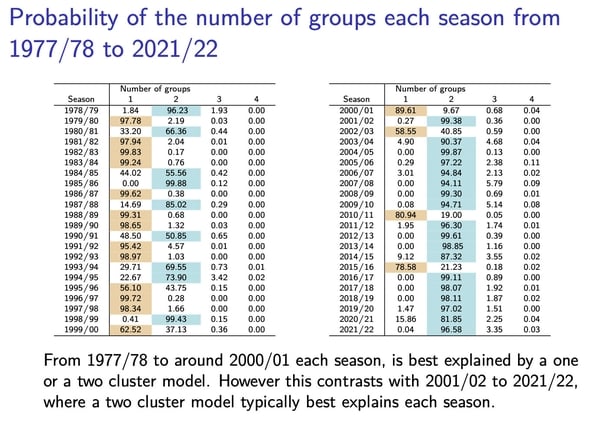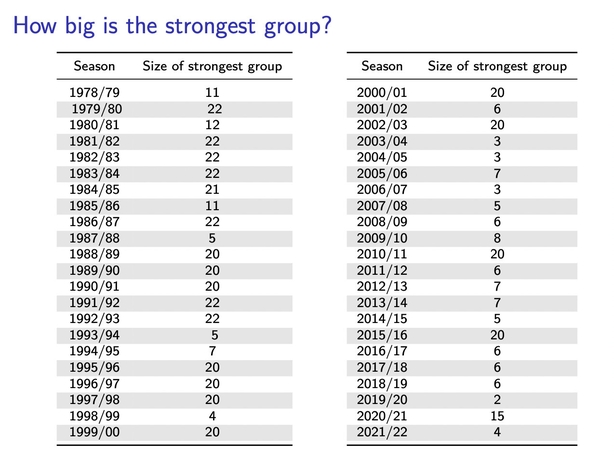Analysis: our data analysis shows how money has killed competition in the Premier League over the last 20 years
By Nial Friel, UCD
In a recent piece in The Independent, Miguel Delaney paints a gloomy picture of soccer's future in the light of Qatar's ongoing attempts to purchase Manchester United from the Glazer family. If the Qatari bid is successful, Manchester United will be the third Premier League team that is effectively state owned: Manchester City was purchased by Sheikh Mansour of the United Arab Emirates in 2008 and Newcastle United has belonged to Saudi Arabia's Public Investment Fund since 2021.
The problems this creates for soccer are manifold – issues of credibility among them – but the most immediate dilemma is lack of competition. Over the last twenty years, money has gradually killed competition in the Premier League, and there is data to prove it.
We need your consent to load this rte-player contentWe use rte-player to manage extra content that can set cookies on your device and collect data about your activity. Please review their details and accept them to load the content.Manage Preferences
From RTÉ Radio 1's Today With Claire Byrne, James Lynch from human rights advocacy group Fairsquare discusses Qatari interest in buying Manchester United
In his article, Delaney cites our recent paper in the Journal of the Royal Statistical Society, Series A. 'Assessing competitive balance in the English Premier League for over forty seasons using a stochastic block model' is a season by season analysis which offers quantitative evidence of a lack of competitiveness emerging in line with TV revenue and external investment since the early 2000s. It tracks a structural change since then, from a reasonably balanced league to an effective two-tier league, with competition within, but not between, the two groups of teams.
Measuring competitive balance is a tricky issue. Several indices have been proposed in the literature for this purpose. For example, one could look at the points spread in a given season and investigate if this spread is increasing over time. If so, this might point to a lack of competition.
We need your consent to load this rte-player contentWe use rte-player to manage extra content that can set cookies on your device and collect data about your activity. Please review their details and accept them to load the content.Manage Preferences
From RTÉ 2fm's Dave Fanning Show, The Independent's Chief Football Writer Miguel Delaney on UK soccer club takeovers and sportswashing
The approach which we take is more nuanced and instead takes account of the outcome of each individual game in a season. There are 380 games every season in the Premier League. Our aim is to investigate if we can probabilistically categorise teams into distinct groups. The broad aim being that teams within each group would be competitive with themselves, but not between groups. The statistical challenge is to estimate how many groups there are and then to estimate which teams should belong to each group.
What insights can this model provide? One of the most important is understanding how many groups best explain the results each season. In other words, what is the probability that the data supports a single group, two groups, three groups and so on. These probabilities in turn allow us to assess competitiveness. This concept can be best explained by example.
We need your consent to load this rte-player contentWe use rte-player to manage extra content that can set cookies on your device and collect data about your activity. Please review their details and accept them to load the content.Manage Preferences
From RTÉ Radio 1's Drivetime, the Irish Daily Star's Chief Sports Writer Kieran Cunningham discusses the issues around sportswashing in soccer and other sports
Consider the 1997/1998 season. We estimate that there is a 98% chance of a single group (consisting of all teams) and a 2% chance of a two group model. This strongly suggests that the league was balanced that season. However, fast forward only a few seasons to 2003/2004 and the situation is dramatically reversed. A one, two and three group model now has respective probabilities of 6%, 88% and 6%. In other words, there is strong quantifiable evidence that the 2003/2004 season can be explained by two well-separated groups of teams pointing to a lack of competitiveness.
In fact, what we found surprising is that the league typically separates into two very well separated groups of teams from the early 2000s to the present. This is in stark contrast to the seasons which preceded it, from the 1980s to the 2000s, where there is generally weak evidence for the separation of teams into two or more groups.

A natural question to ask is how many teams are usually in the top group of teams? This can provide further insight into the competitive nature of the league. If most of the teams in the league belong to the strongest group, then this indicates a reasonable level of competitiveness. However, this decisively wasn't the case. In fact, our statistical model gives the probability that each team belongs to the strongest group, which in turn can tell how many teams are likely to belong to the strongest group.
Once again, it turns out that the seasons around the early 2000s are quite pivotal. Subsequent to that, the most probable number of teams in the strongest group usually contains four to six teams. Of course, the teams in this group are those that we would expect, most recently, Manchester City, Liverpool and so on, the so-called 'big six'.
But it is striking that the probability of membership to this elite group is extremely low for those teams outside this collection of teams. In other words, there appears to be a strong chasm between those elite teams and the rest.

This trend is likely to intensify with the emergence of nation state ownership by wealthy countries seeing off a more diverse (and less oppressively wealthy) set of investors. We might soon yearn for the days when you could count the number of teams meaningfully competing at the highest level on more than one hand.
The effect on teams further down the line could be devastating, as the sheer size of the investments into a handful of top teams eclipses and financially starves teams in lower leagues – indeed, less wealthy teams in the Premier League itself. This lack of competition and resources could choke off the supply of players from local and regional clubs, impoverishing the game in the long term.
This is, in many ways, a parallel of the biodiversity problem. Lack of meaningful competition between a variety of organisms in the natural world is leading to whole scale extinctions that ultimately threaten the entire ecosystem.
Our data modelling maps in stark terms the uncompetitive drift of the Premier League. Can anything be done to arrest the trend? It is my hope that work such as ours can provide the raw material for evidence-based policy decisions at government level in the UK to save the league from itself.
Prof Nial Friel is a professor of statistics in the School of Mathematics and Statistics at UCD and a Principal Investigator with the Machine Learning & Statistics Rsearch Group at the Insight SFI Research Centre for Data Analytics.
The views expressed here are those of the author and do not represent or reflect the views of RTÉ

